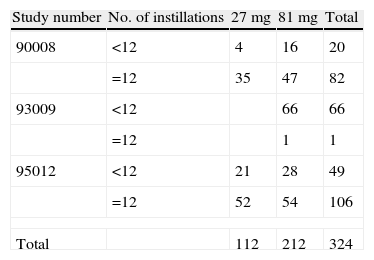To analyze if the true number of BCG instillations applied in non-muscle invasive bladder tumors has any influence on their prognosis as well as other tumor and clinical characteristics: age, sex, different protocols, BCG dose, whether primary or recurrent, solitary or multiple, tumor size G3 or Cis.
Patients and methodsA total of 324 high grade NMIBC (15 TaG3, 184 T1G3, 125 Cis) out of 1491 cases included in the CUETO database were analyzed. Following 6 post transurethral resection (RTU) BCG instillations, the patients were scheduled to receive one instillation every two weeks (3–6 times), for a total of 9–12 instillations. One third of the dose (27mg) (112 cases) or total dose of 81mg (212 cases). Mean follow-up was 59.6 months. Statistical Analysis: Kaplan–Meier, Cox-regression (uni-multivariate).
ResultsA higher level of recurrence (p=0.032) and progression (p=.013) risk as well as worse Ca-specific survival (p=.005) were obtained if there were fewer than 12 instillations with the Kaplan–Meier and Cox-regression multivariate analysis. A 27mg (p=.008) dosage and being a female (p<.001) were independent factors for a higher recurrence risk, but not for progression or Ca-specific survival. The remaining characteristics studied were not statistically significant.
ConclusionsIn accordance with the results obtained, we can conclude that the number of BCG instillations applied has some influence on the outcome of high grade NMIBC. The optimum number of instillations as well as their time of application must still be determined. A dose of 27mg and being a female are predictive factors of recurrence.
Analizar si el número real de instilaciones de BCG aplicadas en los tumores vesicales no músculo-infiltrantes tiene alguna influencia en su pronóstico, así como otras variables clínicas y del tumor: edad, sexo, diferentes protocolos, dosis de BCG, primario o recurrente, G3 o Cis.
Pacientes y métodosDe 1.491 pacientes incluidos en la base de datos del grupo CUETO se analizaron 324 tumores de alto grado (15 TaG3, 184 T1G3, 125 Cis). Tras la inducción de 6 instilaciones de BCG post-RTU fueron programados para recibir una instilación cada 2 semanas (3–6 veces), total 9–12 instilaciones. Un tercio de dosis (27mg) en 112 casos y dosis total (81mg) en 212 casos. Seguimiento medio: 59,6 meses. Análisis estadístico: Kaplan–Meier, regresión de Cox uni y multivariado.
ResultadosCon el análisis de Kaplan–Meier y regresión de Cox multivariado se obtuvo mayor riesgo de recidiva (p=0,032) y progresión (p=0,013), y peor supervivencia cáncer-específica (p=0,005) si < de 12 instilaciones. Dosis de 27mg (p=0,008) y el ser mujer (p<0,001) fueron factores independientes predictivos de mayor recidiva, pero no de mayor progresión ni de peor supervivencia cáncer-específica. El resto de las características estudiadas no fueron estadísticamente significativas.
ConclusionesCon los resultados obtenidos parece que el número de instilaciones aplicadas tiene alguna influencia sobre el pronóstico, quedando por determinar cuál es el mínimo de instilaciones a partir del cual el paciente se puede beneficiar y su tiempo de aplicación. Dosis de 27mg y el ser mujer son factores predictivos para mayor recidiva.
Artículo
Comprando el artículo el PDF del mismo podrá ser descargado
Precio 19,34 €
Comprar ahora











